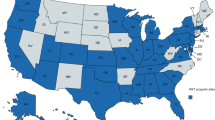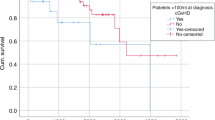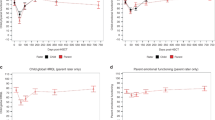Abstract
To investigate the health-related quality of life (HRQoL) of patients receiving allogeneic hematopoietic SCT (allo-HSCT) from HLA-haploidentical/partially matched related donors (HID/PMRD) and to compare this value with that of patients receiving allo-HSCT from HLA-identical sibling donor (ISD), a total of 350 patients receiving allo-HSCT were enrolled in a study (ISD: 173; HID/PMRD: 177). HRQoL post transplantation was evaluated by an SF-36 questionnaire. The effect of various factors on the HRQoL was analyzed through COX regression. Compared with the ISD group, patients in the HID/PMRD group had higher scores in physical functioning, general health, bodily pain, vitality and emotional role functioning, and these patients functioned significantly better on the physical and mental component summaries. Also, long-term survivors exhibit better HRQoL. Measured by multivariate analysis, extensive chronic GVHD was observed to have a strongly negative impact on patients’ HRQoL, while male gender status, lower age when receiving allo-HSCT and returning to work or school were associated with positive impacts on at least one subscale. These results showed that the HRQoL of patients receiving HID/PMRD hematopoietic SCT (HSCT) is comparable to that of patients receiving ISD HSCT, and HLA disparity is not the factor affecting the HRQoL.
This is a preview of subscription content, access via your institution
Access options
Subscribe to this journal
Receive 12 print issues and online access
$259.00 per year
only $21.58 per issue
Buy this article
- Purchase on Springer Link
- Instant access to full article PDF
Prices may be subject to local taxes which are calculated during checkout
Similar content being viewed by others
References
Huang XJ, Liu DH, Liu KY, Xu LP, Chen H, Han W et al. Haploidentical hematopoietic stem cell transplantation without in vitro T cell depletion for the treatment of hematological malignancies. Bone Marrow Transplant 2006; 38: 291–297.
Han W, Lu DP, Huang XJ, Liu KY, Chen H, Xu LP et al. Mismatched hematopoietic stem cell transplantation using GIAC protocol: report of 100 cases. Zhonghua Xue Ye Xue Za Zhi 2004; 25: 453–457.
Baker KS, Gurney JG, Ness KK, Bhatia R, Forman SJ, Francisco L et al. Late effects in survivors of chronic myeloid leukemia treated with hematopoietic cell transplantation: results from the Bone Marrow Transplant Survivor Study. Blood 2004; 104: 1898–1906.
Wong FL, Francisco L, Togawa K, Bosworth A, Gonzales M, Hanby C et al. Long-term recovery after hematopoietic cell transplantation: predictors of quality-of-life concerns. Blood 2010; 115: 2508–2519.
Fraser CJ, Bhatia S, Ness K, Carter A, Francisco L, Arora M et al. Impact of chronic graft-versus-host disease on the health status of hematopoietic cell transplantation survivors: a report from the Bone Marrow Transplant Survivor Study. Blood 2006; 108: 2867–2873.
Kopp M, Schweigkofler H, Holzner B, Nachbaur D, Niederwieser D, Fleischhacker WW et al. Time after bone marrow transplantation as an important variable for quality of life: results of a cross-sectional investigation using two different instruments for quality-of-life assessment. Ann Hematol 1998; 77: 27–32.
Sutherland HJ, Fyles GM, Adams G, Hao Y, Lipton JH, Minden MD et al. Quality of life following bone marrow transplantation: a comparison of patient reports with population norms. Bone Marrow Transplant 1997; 19: 1129–1136.
Duell T, van Lint MT, Ljungman P, Tichelli A, Socié G, Apperley JF et al. Health and functional status of long-term survivors of bone marrow transplantation. EBMT Working Party on Late Effects and EULEP Study Group on Late Effects. European Group for Blood and Marrow Transplantation. Ann Intern Med 1997; 126: 184–192.
Syrjala KL, Langer SL, Abrams JR, Storer B, Sanders JE, Flowers ME et al. Recovery and long-term function after hematopoietic cell transplantation for leukemia or lymphoma. JAMA 2004; 291: 2335–2343.
Bush NE, Donaldson GW, Haberman MH, Dacanay R, Sullivan KM . Conditional and unconditional estimation of multidimensional quality of life after hematopoietic stem cell transplantation: a longitudinal follow-up of 415 patients. Biol Blood Marrow Transplant 2000; 6: 576–591.
Chiodi S, Spinelli S, Ravera G, Petti AR, Van Lint MT, Lamparelli T et al. Quality of life in 244 recipients of allogeneic bone marrow transplantation. Br J Haematol 2000; 110: 614–619.
Bieri S, Roosnek E, Helg C, Verholen F, Robert D, Chapuis B et al. Quality of life and social integration after allogeneic hematopoietic SCT. Bone Marrow Transplant 2008; 42: 819–827.
Bush NE, Haberman M, Donaldson G, Sullivan KM . Quality of life of 125 adults surviving 6–18 years after bone marrow transplantation. Soc Sci Med 1995; 40: 479–490.
Przepiorka D, Weisdorf D, Martin P, Klingemann HG, Beatty P, Hows J et al. 1994 Consensus Conference on Acute GVHD Grading. Bone Marrow Transplant 1995; 15: 825–828.
Sullivan KM, Shulman HM, Storb R, Weiden PL, Witherspoon RP, McDonald GB et al. Chronic graft-versus-host disease in 52 patients: adverse natural course and successful treatment with combination immunosuppression. Blood 1981; 57: 267–276.
Ware JE, Kosinski M, Bayliss MS, McHorney CA, Rogers WH, Raczek A . Comparison of methods for the scoring and statistical analysis of SF-36 health profile and summary measures: summary of results from the Medical Outcomes Study. Med Care 1995; 33 (suppl): AS264–AS279.
Li L, Wang HM, Shen Y . Chinese SF-36 Health Survey: translation, cultural adaptation, validation, and normalisation. J Epidemiol Community Health 2003; 57: 259–263.
Worel N, Biener D, Kalhs P, Mitterbauer M, Keil F, Schulenburg A et al. Long-term outcome and quality of life of patients who are alive and in complete remission more than two years after allogeneic and syngeneic stem cell transplantation. Bone Marrow Transplant 2002; 30: 619–626.
Sanders JE, Hoffmeister PA, Storer BE, Appelbaum FR, Storb RF, Syrjala KL . The quality of life of adult survivors of childhood hematopoietic cell transplant. Bone Marrow Transplant 2010; 45: 746–754.
Higman MA, Vogelsang GB . Chronic graft versus host disease. Br J Haematol 2004; 125: 435–454.
Teshima T, Matsuo K, Matsue K, Kawano F, Taniguchi S, Hara M et al. Impact of human leucocyte antigen mismatch on graft-versus-host disease and graft failure after reduced intensity conditioning allogeneic haematopoietic stem cell transplantation from related donors. Br J Haematol 2005; 130: 575–587.
Lu DP, Dong L, Wu T, Huang XJ, Zhang MJ, Han W et al. Conditioning including antithymocyte globulin followed by unmanipulated HLA-mismatched/haploidentical blood and marrow transplantation can achieve comparable outcomes with HLA-identical sibling transplantation. Blood 2006; 107: 3065–3073.
Chen XH, Gao L, Zhang X, Gao L, Zhang C, Kong PY et al. HLA-haploidentical blood and bone marrow transplantation with anti-thymocyte globulin: long-term comparison with HLA-identical sibling transplantation. Blood Cell Mol Dis 2009; 43: 98–104.
Basara N, Baurmann H, Kolbe K, Yaman A, Labopin M, Burchardt A et al. Antithymocyte globulin for the prevention of graft-versus-host disease after unrelated hematopoietic stem cell transplantation for acute myeloid leukemia: results from the multicenter German cooperative study group. Bone Marrow Transplant 2005; 35: 1011–1018.
Bacigalupo A, Lamparelli T, Barisione G, Bruzzi P, Guidi S, Alessandrino PE et al. Thymoglobulin prevents chronic graft-versus-host disease, chronic lung dysfunction, and late transplant-related mortality: long-term follow-up of a randomized trial in patients undergoing unrelated donor transplantation. Biol Blood Marrow Transplant 2006; 12: 560–565.
Bacigalupo A, Lamparelli T, Bruzzi P, Guidi S, Alessandrino PE, di Bartolomeo P et al. Antithymocyte globulin for graft-versus-host disease prophylaxis in transplants from unrelated donors: 2 randomized studies from Gruppo Italiano Trapianti Midollo Osseo (GITMO). Blood 2001; 98: 2942–2947.
Temple RO, Carvalho J, Tremont G . A national survey of physicians’ use of and satisfaction with neuropsychological services. Arch Clin Neuropsychol 2006; 21: 371–382.
Paller AS, McAlister RO, Doyle JJ, Jackson A . Perceptions of physicians and pediatric patients about atopic dermatitis, its impact, and its treatment. Clin Pediatr (Phila) 2002; 41: 323–332.
Byrne NM, Hardy L . Community physiotherapy for children with cystic fibrosis: a family satisfaction survey. J Cyst Fibros 2005; 4: 123–127.
Acknowledgements
This work was partly supported by the National Outstanding Young Scientist's Foundation of China (Grant No. 30725038), Program for Innovative Research Team in University (Grant No. IRT 0702). This manuscript had been edit by Matthew Bayer, PhD of American Journal Experts.
Author information
Authors and Affiliations
Corresponding author
Ethics declarations
Competing interests
The authors declare no conflict of interest.
Rights and permissions
About this article
Cite this article
Mo, XD., Xu, LP., Liu, DH. et al. Patients receiving HLA-haploidentical/partially matched related allo-HSCT can achieve desirable health-related QoL that is comparable to that of patients receiving HLA-identical sibling allo-HSCT. Bone Marrow Transplant 47, 1201–1205 (2012). https://doi.org/10.1038/bmt.2011.250
Received:
Revised:
Accepted:
Published:
Issue Date:
DOI: https://doi.org/10.1038/bmt.2011.250
Keywords
This article is cited by
-
Unrelated donor hematopoietic stem cell transplantation compared to immunosuppressive therapy plus eltrombopag as first-line treatment for adults with severe aplastic anemia
Blood Cancer Journal (2024)
-
Long-term survivors demonstrate superior quality of life after haploidentical stem cell transplantation to matched sibling donor transplantation
Journal of Translational Medicine (2022)
-
Allogeneic hematopoietic stem cell transplantation for intermediate-risk acute myeloid leukemia in the first remission: outcomes using haploidentical donors are similar to those using matched siblings
Annals of Hematology (2021)
-
Prognosis and risk factors for central nervous system relapse after allogeneic hematopoietic stem cell transplantation in acute myeloid leukemia
Annals of Hematology (2021)
-
Haploidentical donor is preferred over matched sibling donor for pre-transplantation MRD positive ALL: a phase 3 genetically randomized study
Journal of Hematology & Oncology (2020)



